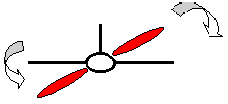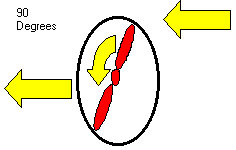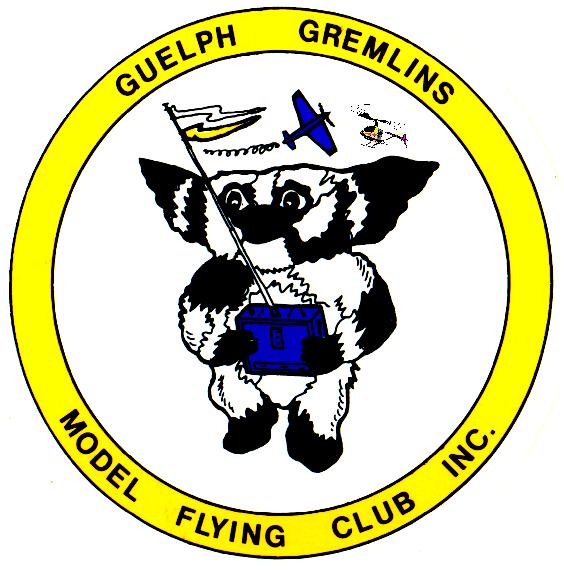|
| |
|
Have
you ever noticed that you need a little extra right rudder on take-off?
Would you like your plane to track a straighter line?
Do you support Stockwell Day changing his first name to Doris?
But I digress. Why do
planes veer to the left during the take off, climb out or during a
go-around? The answer lies in
the propeller.
The four main reasons
that a plane tends to the left are: torque from the engine, slipstream
from the propeller, greater thrust from the down going blade and
gyroscopic effect. Lets look
at each individually.
Sir Isaac Newton’s third law
(made famous by Garfield) states that “for every action there is an
equal and opposite reaction”. The
torque from the engine causes the propeller and aircraft to rotate in
opposite directions. When the
crankshaft and propeller rotate clockwise (when viewed from the tail of
the plane), the reaction is for the plane to rotate counter-clockwise.
The left wing drops and the plane veers to the left
|
| Plane
turns counter-clockwise |
 |
Propeller
turns clockwise |
| The
next reason is slipstream. The
airflow comes off the propeller in a corkscrewing pattern.
The air rotates clockwise around the fuselage and strikes the
rudder on the left side. The
rudder is pushed to the right and the plane goes to the left |
| |
|
|
| |
 |
|
| |
|
|
| The
next cause of left veering aircraft is just a wee bit more complicated.
First, lets remember that one of the components for the lift
formula is velocity squared (the faster you go, the more lift you get).
Next, this formula also applies to thrust since a propeller is
nothing more than a rotating wing. Ok,
here goes. Essentially, because the plane has a slightly positive (nose
up) angle, the downward going (right hand) blade of the propeller moves
slightly forward and has a slightly greater relative velocity than the
upward going (left hand) blade which moves slightly backward. The result is slightly more thrust on the right side of the
propeller and a tendency for the plane to, you guessed it, veer left.
Let’s extrapolate this to the extreme.
Lets assume that the plane has 90o nose up attitude and
that the propeller is now rotating parallel to the relative airflow.
The right blade is moving upwind, creating all sorts of lift and
left blade is moving downwind, creating very little lift.
You are now into a situation where you must increase Angle of
Attack of the downwind (left) blade in order to generate an amount lift
equal to the upwind (right) blade. This
is exactly the problem that our helicopter friends face and it is the
price that they must pay for insisting on flying an airplane at 900. |
| |
|
|
|
The
last cause of left veering airplanes is gyroscopic effect.
Have you ever held a spinning bike tire and noticed that it is very
hard to control. This is
because a force applied to a gyro (spinning disk) will act at 900. Let’s say you held a clockwise spinning bike tire
vertically and applied a force to the top.
The force would be transposed 900 and the right side
would move. When a propeller
is turning, it becomes a disk with all of the properties of a gyro.
So there you are barreling down the runway in your brand spanking
new Piper Cub, you raise the tail (which applies a force to the top of the
propeller, which is transposed 900 to the right side of the
propeller) and your plane veers left. |
| |
|
|
| |
 |
|
| |
|
|
| So
now that we know the causes, what are the solutions.
The simplest way to stop the plane veering left is to turn the
propeller in the opposite direction, and the plane would then veer right.
Another way would be to have one propeller turning clockwise and
another one turning counter-clockwise.
The two forces would cancel each other out and your plane would
track nice and straight. Problem
is, it is very mechanically complicated to build a counter-rotating
engine. On the bright side,
you would steal the show at the Scale Masters if you showed up with a
counter-rotating RC engine. We
could get rid of the propeller all together and install a jet in out Piper
Cup (another good way to steal the show).
You could set in some rudder trim, but this would only be good at a
particular speed or you could build some offset into your firewall.
By angling the engine towards the right (30 seems to be
a good starting point) you counteract the plane wanting to go left.
Lastly, and this is my goal for the coming year, you could become
more proficient with the rudder. |
| |
|
|
|
Questions
or comments
Craig
Skinner
kc.skinner@sympatico.ca
|
|
|
|
 Guelph
Gremlins Model Flying
Club
Guelph
Gremlins Model Flying
Club